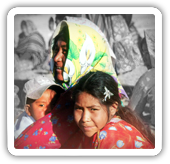According to Mexican tourism officials, magical experiences and eco-adventures await those who travel to the remote mountains and canyons of the Sierra Tarahumara in the border state of Chihuahua. They also assure tourists that they will be safe and that the native Tarahumara people are the major beneficiaries of the government-sponsored tourism industry.
The Tarahumara, who call themselves Rarámuri (roughly, the “running people”), have a different view of the government’s megaproyecto. While they initially welcomed the plan to attract more tourists to visit this spectacular but hard-to-access region, they now regard the project as another threat to their survival—along with the current gold-mining boom, massive illegal logging, drug-trafficking gangs, and the intrusions of mestizo ranchers.
The Barrancas del Cobre (Copper Canyon) tourism megaproject, named after the six immense copper-hued canyons that cut through the Sierra Madre, has been in the works since the mid-1990s. New roads, a large airport, and an adventure park located on the scenic rim of the Barrancas are now open; still to come are luxury hotels, a golf course, and an aqueduct that will pump water to the tourist complex.
In 1995–96 Mexico received funding from the World Bank and Inter-American Development Bank to help jump start the project. According to the federal tourism ministry, the project would improve the conditions of the deeply impoverished people who have inhabited the area since centuries before the Spanish conquest.
With their colorful dress, primitive living conditions, crafts, and resistance to acculturation, the Tarahumara were the centerpiece of official plans to develop the tourism industry. State and federal governments teamed up to create and promote “magical routes” into the hamlets, or “magical towns.”
Such highway signs might be dismissed as nothing more than fodder for vacationers. But Mexican tourism promoters aren’t the first to find the Tarahumara magical. In the mid-1930s, surrealist Antonin Artaud observed, “These are people who defy the time, who do not recognize our reality, and instead draw magical powers from the mistrust they have for our civilization.” Even those who miss the magic and power of the Tarahumara are not immune to the natural marvels of their homeland, where the mountains are high and the river gorges are deeper than the Grand Canyon.
By some measures, the tourism project has been a terrific success. Hotels are brimming; travelers line up at the adventure park for bungee jumping and cable-car and zip-line rides into the canyon. But as the number of tourists grows, the promised benefits are being questioned by the Tarahumara and nongovernmental organizations that form the Chihuahua City–based Tarahumara Defense Network.
Tarahumara communities, many of which depend economically on the sale of their baskets and other crafts, hoped the investments would be both environmentally and culturally conscious, as promised. But the indigenous now claim that the megaproject is a “white elephant” trampling their rights, destroying their traditional subsistence economies, and contaminating their water supplies.
To create the adventure park, the state government, with the help of politically connected private investors, expropriated land from two Tarahumara communities; the government claims they didn’t exist because they lacked the proper papers. And hotels routinely dump their solid and liquid wastes into the canyon, contaminating springs and leading to outbreaks of rashes and intestinal illnesses. The Tarahumara see a version of Disneyland behind barbed-wire fences that keeps the tourists safe and the natives out. Families have started leaving, hoping to scrape by in the cities or as farm workers.
Not everyone is backing away, though, even if their only water comes from seeps contaminated by the very tourists zipping on cables overhead. Locals are demanding their rights in Mexican and international courts and have organized protests in front of the governor’s palace. Together with the Tarahumara Defense Network, they are becoming activists, a role they haven’t occupied since their rebellion against the Spanish in the late 1600s.






